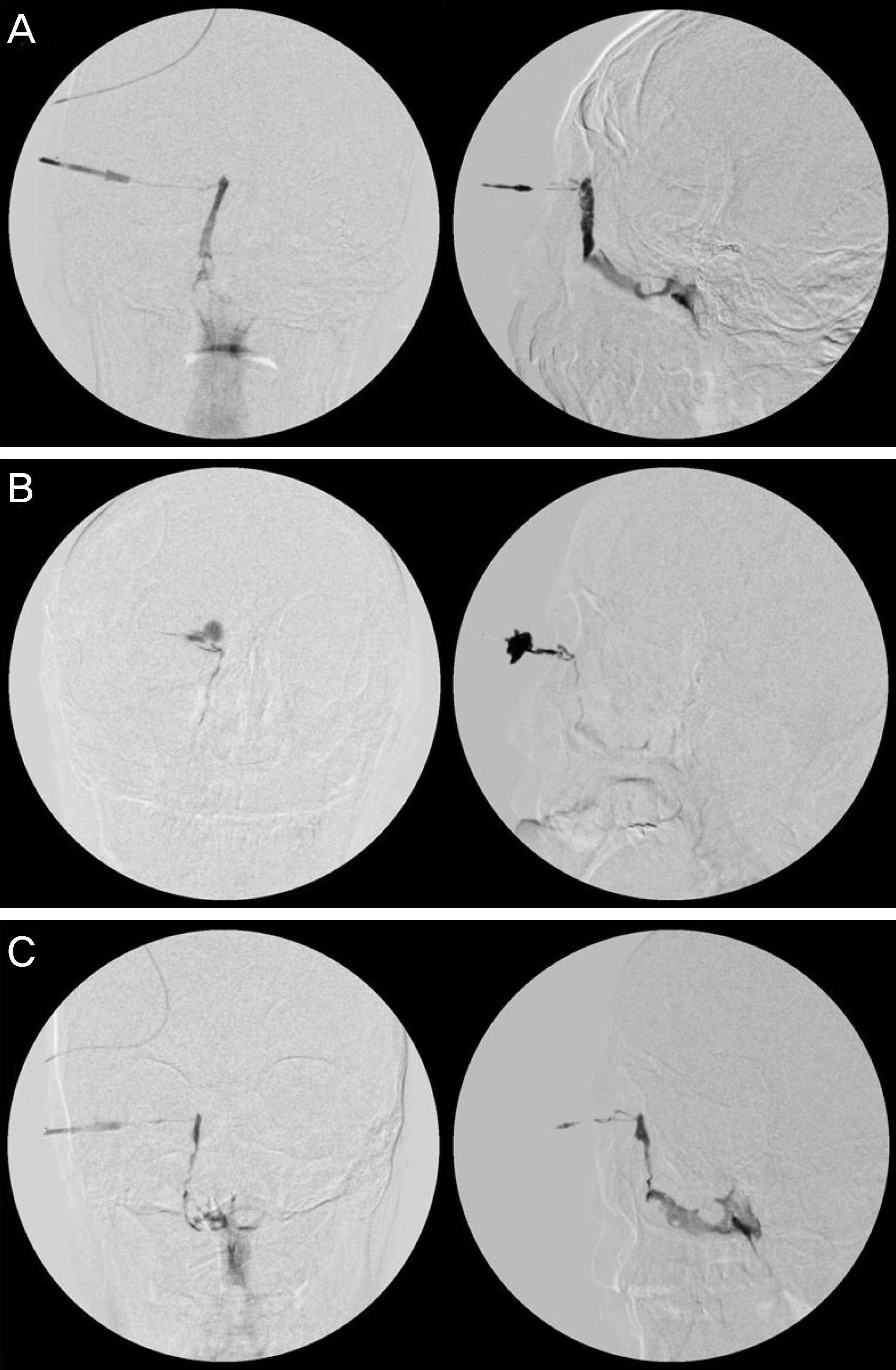Abstract
Purpose
To compare the surgical success rate of silicone tube intubation according to the preoperative lacrimal syringing test and dacryocystography (DCG) in adult patients with epiphora.
Methods
Medical records of 142 patients who underwent silicone tube intubation were retrospectively reviewed. The surgical results were divided into 3 groups based on postoperative symptoms and the syringing test results: Good, Fair, and Fail. Good and Fair were classified into the surgical success groups. We compared the surgical success rate according to the preoperative syringing test and stenosis site observed on dacryocystography.
Results
The success rates of silicone tube intubation were 88.4% and 87.4% in eyes with preoperative syringing results of totally-passed and partially-passed syringing tests, respectively, revealing no statistically significant differences (p = 0.838, chi-square test). However, in eyes with the preoperative syringing results of partially-passed syringing tests, the success rates were 66.7% in patients with canalicular stenosis, 83.3% in patients with nasolacrimal duct stenosis, and 94.5% in those with diffuse stenosis (p = 0.018, chi-square test).
Conclusions
No significant differences were found in the success rates of silicone tube intubation according to preoperative syringing test results. However, when considered together with DCG findings, the lowest success rate was found in eyes with the partially-passed syringing test and simultaneously showed canalicular stenosis on DCG. The syringing test results considered with DCG findings may help predict the success rates of silicone tube intubation.
Go to : 
References
2. Lim CS, Martin F, Beckenham T, Cumming RG. Nasolacrimal duct obstruction in children: outcome of intubation. J AAPOS. 2004; 8:466–72.

3. Beigi B, O'Keefe M. Results of Crawford tube intubation in children. Acta Ophthalmol (Copenh). 1993; 71:405–7.

4. Dortzbach RK, France TD, Kushner BJ, Gonnering RS. Silicone intubation for obstruction of the nasolacrimal duct in children. Am J Ophthalmol. 1982; 94:585–90.

5. Kashkouli MB, Kempster RC, Galloway GD, Beigi B. Monocanalicular versus bicanalicular silicone intubation for nasolacrimal duct stenosis in adults. Ophthal Plast Reconstr Surg. 2005; 21:142–7.

6. Fulcher T, O'Connor M, Moriarty P. Nasolacrimal intubation in adults. Br J Ophthalmol. 1998; 82:1039–41.

7. Choi CU, Seo SW, Kim SD. The comparison of punctoplasty and silicone tube intubation in patients with punctal obstruction. J Korean Ophthalmol Soc. 2008; 49:543–7.

8. Oum JS, Park JW, Choi YK, et al. Result of partial nasolacrimal duct obstruction after silicone tube intubation. J Korean Ophthalmol Soc. 2004; 45:1777–82.
9. Lee SH, Kim SD, Kim JD. Silicone intubation for nasolacrimal duct obstruction in adult. J Korean Ophthalmol Soc. 1997; 38:185–9.
10. Kim HD, Jeong SK. Silicone tube intubation in acquired nasolacrimal duct obstruction. J Korean Ophthalmol Soc. 2000; 41:327–31.
11. Sohn HY, Hur J, Chung EH, Won IG. Clinical observation on silicone intubation in obstruction of lacrimal drainage system. J Korean Ophthalmol Soc. 1990; 31:135–40.
12. Kwon YH, Lee YJ. Long-term results of silicone tube intubation in incomplete nasolacrimal duct obstruction (NLDO). J Korean Ophthalmol Soc. 2008; 49:190–4.

13. Connell PP, Fulcher TP, Chacko E, et al. Long term follow up of nasolacrimal intubation in adults. Br J Ophthalmol. 2006; 90:435–6.

14. Inatani M, Yamauchi T, Fukuchi M, et al. Direct silicone intubation using Nunchaku-style tube (NST-DSI) to treat lacrimal passage obstruction. Acta Ophthalmol Scand. 2000; 78:689–93.

15. Suh SC, Ha MS. Silicone intubation and dacryocystographic finding in incomplete nasolacrimal duct obstruction. J Korean Ophthalmol Soc. 2009; 50:491–6.

16. Kim JS, Ahn M. Clinical evaluation and classification of nasolacrimal duct obstruction site by dacryocystography. J Korean Ophthalmol Soc. 2005; 46:191–5.
Go to : 
 | Figure 1.Representative photographs of dacryocystography (DCG) images. (A) Canalicular stenosis. (B) Nasolacrimal duct stenosis. (C) Both canalicular and nasolacrimal duct stenosis. |
Table 1.
Patient demographics
Table 2.
Success rates according to syringing tests (n = 173)
| Syringing test | Success rate | p-value∗ |
|---|---|---|
| Complete passing | 88.4% (76/86) | 0.838 |
| Partial passing | 87.4% (76/87) |
Table 3.
Success rates according to the stenosis site in dacryocystography (n = 155)
| Site of stenosis | Success rate | p-value∗ |
|---|---|---|
| Canalicular stenosis | 80.0% (20/25) | 0.351 |
| Nasolacrimal duct stenosis | 87.5% (7/8) | |
| Canalicular + nasolacrimal duct stenosis | 90.2% (110/122) |
Table 4.
Success rate according to the stenosis site by dacryocystography in complete passed eyes
| Site of stenosis | N = 82 | Success rate (%) | p-value∗ |
|---|---|---|---|
| Canalicular stenosis | 13 | 92.3 | 0.734 |
| Nasolacrimal duct stenosis | 2 | 100 | |
| Canalicular + nasolacrimal duct stenosis | 67 | 86.6 |
Table 5.
Success rate according to the stenosis site by dacryocystography in partial passed eyes
| Site of stenosis | N = 73 | Success rate (%) | p-value∗ |
|---|---|---|---|
| Canalicular stenosis | 12 | 66.7 | 0.018 |
| Nasolacrimal duct stenosis | 6 | 83.3 | |
| Canalicular + nasolacrimal duct stenosis | 55 | 94.5 |




 PDF
PDF ePub
ePub Citation
Citation Print
Print


 XML Download
XML Download